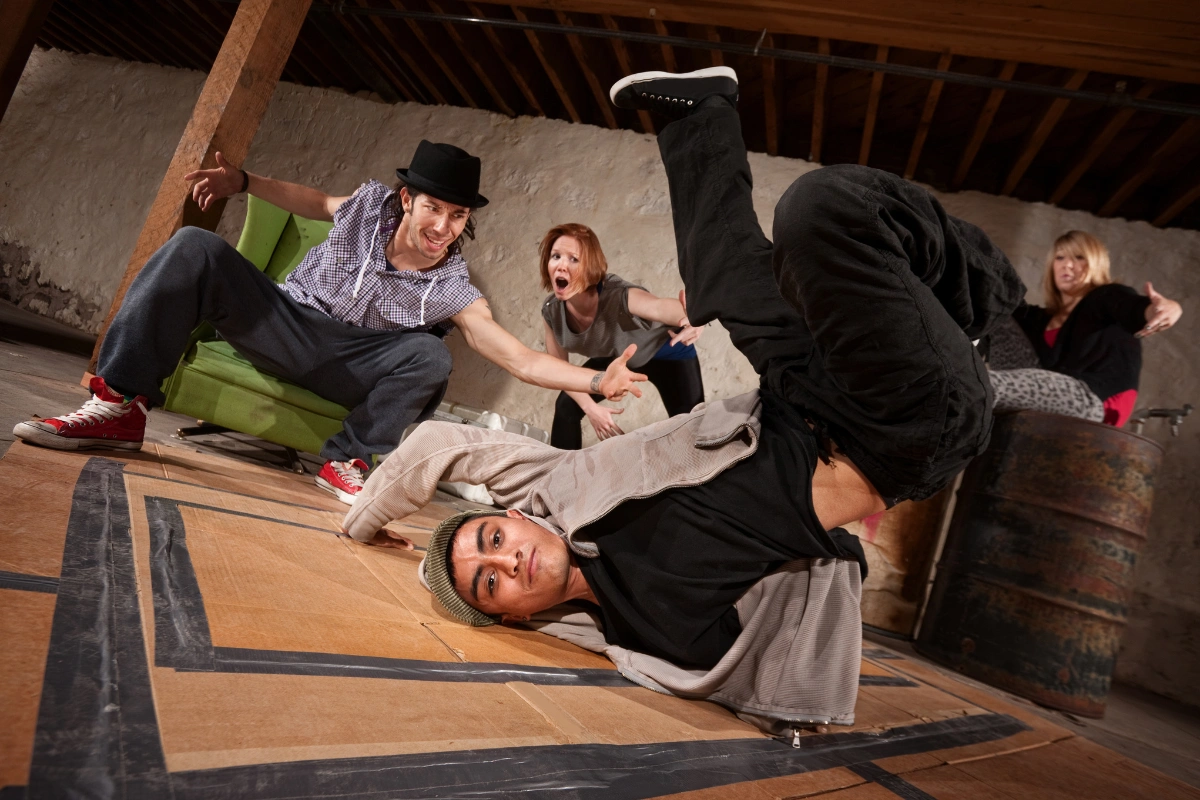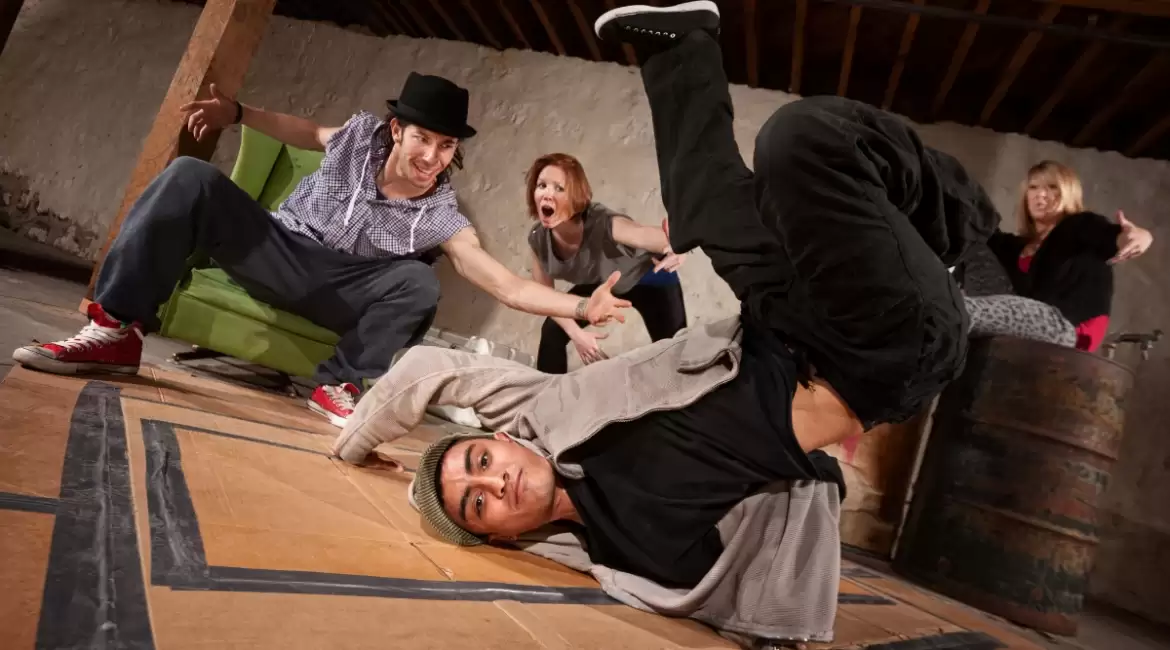Embarking on the journey of breakdancing can be both exhilarating and daunting, especially for beginners. Aspiring breakers often find themselves mesmerized by the electrifying performances of seasoned dancers, wondering where to even begin. Fear not, as breaking, with its rich history and diverse array of moves, offers an accessible entry point for newcomers eager to explore this vibrant art form. In this guide, we’ll delve into the realm of breakdancing and uncover the top five easy breakdance moves tailored specifically for beginners. Whether you’re a complete novice or someone looking to expand their repertoire, these foundational moves serve as the perfect starting point on your breakdance odyssey.
From freezes that defy gravity to footwork sequences that mesmerize the audience, each move on this list has been carefully selected to provide a balance of simplicity and excitement. While the journey to mastery may seem daunting, rest assured that with dedication, patience, and a willingness to learn, you’ll be unleashing your inner b-boy or b-girl in no time.
So, dust off those sneakers, clear some space, and get ready to dive headfirst into the dynamic world of breakdancing. Whether you’re practicing in your bedroom or showcasing your skills on the streets, these top five easy breakdance moves will set you on the path to becoming a confident and versatile dancer. Are you ready to break it down? Let’s dive in!
The Salsa Step

The Salsa Step serves as an integral initiation into the world of breaking, typically commencing with a foundational practice known as top rock. Among the fundamental maneuvers embraced by novices delving into the breaking scene, the kick step stands out as a pivotal element.
Mastering the salsa step unveils a straightforward yet impactful motion that seamlessly integrates into various primary footwork styles. At its core, it entails extending one leg forward while simultaneously executing a lateral step with the other.
While seemingly uncomplicated, refining your breaking prowess entails elevating the salsa step by alternating between legs and infusing dynamic arm movements, thereby enhancing both equilibrium and flair. Ideally, this should constitute a cornerstone of your training regimen, fostering synchronization with the pulsating cadence and fluidity inherent in breaking.
6-Step
Transitioning from the foundational kick step, aficionados of breaking delve into another quintessential move: the 6-step. This iconic footwork sequence not only enriches one’s repertoire but also serves as a vehicle for honing impeccable b-boy/girl technique.
To execute the 6-step:
- Assume a squatting stance to initiate the sequence.
- Propel your right foot forward.
- In tandem, extend your left leg backward.
- Retract your right foot to a rearward position.
- Advance your left foot to the forefront.
- Proceed to slide your right leg underneath your body, culminating in a return to the initial squatting posture with your left foot positioned forward.
The 6-step transcends mere transitional utility within a routine; it embodies an essential facet of the perfect practice regimen, ideal for priming the body at the onset of a session.
Upon mastering the basic rendition of the 6-step, aficionados can explore a myriad of variations, such as executing the sequence in reverse, thereby adding layers of complexity to their repertoire.
The Headstand

When delving into the realm of breaking, the headstand emerges as a quintessential feat that often captivates onlookers and garners admiration from enthusiasts worldwide, particularly when witnessing the top-tier b-boys showcase their prowess. These gravity-defying maneuvers not only serve to dazzle audiences but also underscore the dancer’s remarkable athleticism and control. However, for novices venturing into the realm of headstands, it’s imperative to approach with caution and prioritize safety.
Mastering the headstand necessitates harnessing core stability and arm strength, as these form the bedrock of executing the maneuver with finesse. It’s crucial to underscore the importance of practicing on a suitable surface to mitigate the risk of injury, opting for a cushioned dance mat or padded floor to cushion the impact. Given the delicate nature of the neck and spine, it’s paramount to exercise prudence and avoid attempting the headstand on hard surfaces.
To initiate the headstand:
- Assume a kneeling position, with hands planted firmly on the ground shoulder-width apart.
- Position the crown of the head between the palms, forming a triangular base with the head and hands.
- Gradually lift the hips, utilizing core strength, and propel into the headstand position with a gentle push, ensuring a controlled ascent.
Repetition serves as a key component of mastering the headstand, with consistent practice at home facilitating proficiency and endurance. For those grappling with balance issues, utilizing a wall as support can aid in refining stability and minimizing the risk of injury. As confidence burgeons, aspiring breakers can gradually wean off the wall support, progressively honing their ability to sustain the headstand unaided.
Once the headstand becomes second nature, enthusiasts can progress to more intricate maneuvers, such as mastering the art of the headspin, thereby unlocking new dimensions of creativity and technical prowess within the realm of breaking.
Backspin
Originating from the vibrant streets and dance floors of New York City during the culturally rich era of the 1970s, the backspin stands as an enduring testament to the ingenuity and creativity of breaking pioneers. Among these luminaries, Jo-Jo, a legendary figure in the annals of breaking, is credited with crafting this iconic maneuver, which continues to captivate enthusiasts and spectators alike.
Despite its seemingly uncomplicated facade, the backspin harbors a profound legacy within the breaking community, serving as a cornerstone of the art form’s evolution. Renowned for its accessibility, this powermove offers a gateway for novices to embark upon their breaking journey, as it necessitates less overt athleticism compared to other maneuvers, thereby obviating the need for prodigious strength.
To initiate the backspin:
- Assume a seated position on the dance floor, poised for action.
- Transition into a supine posture, lying flat on your back, and draw your knees close to your chest in preparation.
- Executing a swift and coordinated movement, extend your legs outward while simultaneously leveraging the strength of your arms to propel yourself into a rotational motion, pivoting on your upper back.
Once ensconced in the whirlwind of the backspin, aficionados are encouraged to perpetuate the momentum, striving to prolong the duration of the spin with finesse and control. Moreover, the versatility of this powermove extends beyond mere execution; practitioners are encouraged to explore seamless transitions into and out of the backspin, thereby weaving a tapestry of fluid movement and expression.
As aspiring breakers endeavor to incorporate the backspin into their repertoire, diligent practice coupled with a spirit of experimentation will undoubtedly yield dividends, fostering not only technical proficiency but also a deeper appreciation for the artistry and innovation inherent in breaking.

Simple Freeze
In the dynamic realm of breaking, freezes emerge as an indispensable facet, serving as a canvas for dancers to showcase their technical prowess and distinctive style. Halting one’s motion abruptly and striking a captivating pose or position requires not only agility but also a profound understanding of body control amidst the ceaseless rhythm of the dance.
Much akin to mastering the intricate mechanics of the windmill, integrating a repertoire of basic freezes into one’s routine infuses a dash of individuality and finesse. Among these foundational freezes, the simple freeze stands out as an accessible entry point for budding breakers, offering a platform to cultivate foundational skills and refine technique.
Embarking upon the journey of mastering the crab freeze, novices can follow these step-by-step instructions:
- Begin in a seated position on the floor, ensuring that your feet are planted firmly with knees bent.
- Position your hands behind your body, ensuring that your fingers are directed away from your torso to optimize stability.
- Elevate your hips off the ground, extending both your arms and legs in a coordinated motion.
- Utilize a delicate balance between your hands and feet to stabilize your position, resembling the structure of a “table.”
- Maintain the stability of the freeze for as long as possible, epitomizing poise and control amidst the fluidity of movement.
Executing the crab freeze necessitates not only the cultivation of core strength but also a keen awareness of one’s physical limitations. Aspiring breakers are reminded to heed their body’s cues and progress gradually, steering clear of the temptation to push beyond their current capabilities. Regrettably, a common pitfall encountered by novices is the propensity to exert undue force, risking injury in pursuit of mastering intricate maneuvers like the crab freeze.
By fostering a mindful approach to practice and prioritizing holistic development, dancers can pave the way for sustained progress and longevity within the realm of breaking, thereby embarking upon a journey characterized by both technical proficiency and physical well-being.
Summary
This guide explores the realm of breakdancing through the lens of beginners, offering a curated selection of the top five easy breakdance moves. Recognizing the initial challenges faced by newcomers to the art form, the guide aims to provide accessible entry points into the dynamic world of breaking.
From foundational freezes to basic footwork sequences, each move on the list is chosen for its simplicity and potential for excitement. The guide emphasizes the importance of dedication, patience, and a willingness to learn, assuring readers that with consistent practice, they can master these fundamental moves.
With an engaging introduction inviting readers to embark on their breakdance journey, the guide sets a motivating tone, encouraging individuals to embrace their inner b-boy or b-girl. Whether practicing in the comfort of their own space or showcasing their skills in public, beginners are equipped with the tools to confidently explore the dynamic art form of breakdancing.


Leave a reply